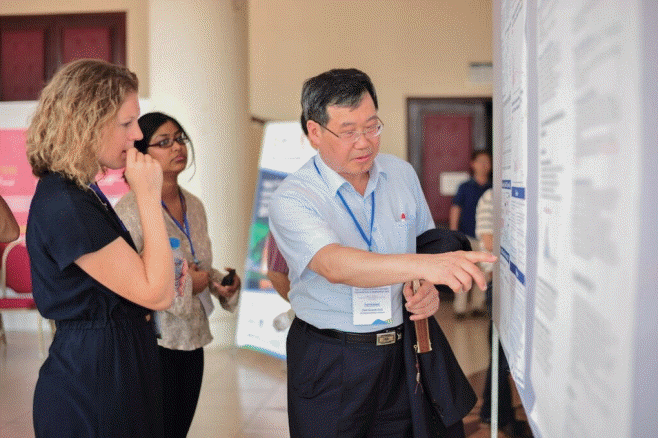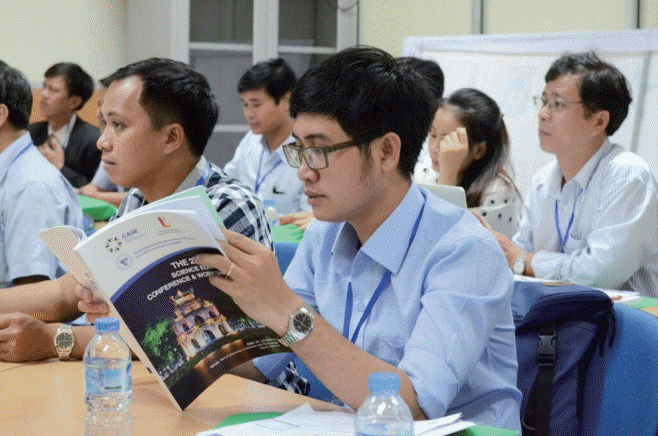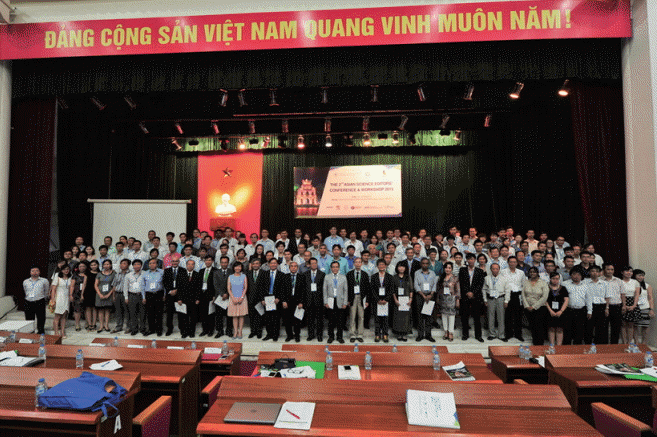The second Asian Science Editors’ Conference and Workshop or CASE2015 was held on August 20 to 22, 2015, at the Hanoi University of Science and Technology (HUST), Hanoi, Vietnam. The event was co-hosted by HUST, the Council of Asian Science Editors (CASE), the Korean Federation of Science and Technology Societies (KOFST), and the Association of Academies and Societies of Sciences in Asia. It provided a platform for editors across Asia to gather and discuss ways in which scientific journals of Asia could be advanced to those of international standards. A total of 252 participants from six countries such as India, Japan, Korea, Singapore, UK, and Vietnam convened, and a wide-range of issues were discussed broadly in some areas and in greater depth in others but for the same purpose of striving to improve the quality of scientific publication (Fig. 1). The CASE2015 marked a new milestone within the Vietnamese scientific community with the launch of a national association, the Vietnamese Council of Science Editors (VCSE).
A pre-conference workshop was held on the 20th of August. It consisted of the following 4 parallel sessions: “Journal article tag suite (JATS) XML, CrossRef XML, and Science Central”; “Bridging the gap between your journal and your authors”; “Assessing a manuscript in house before sending for peer review”; and “Working with peer reviewers and publication ethics”. The presentation files for all the sessions of the event can be downloaded from http://asianeditor.org/event/2015/index.php. I presented the first of these sessions and aided the practical section of it. The session introduced JATS XML, which may still be an unfamiliar concept to editors in Vietnam, and facilitated their understanding by going through its working application on an actual journal homepage. The session also looked at ScienceCentral created by KOFST, a database of free or open access full text from scientific journals. The concept of CrossRef XML and the diverse services of CrossRef such as CrossMark, FundRef, Text and Data Mining were also highlighted. What was most distinctive of this workshop was that a one-to-one sitting with the speaker was provided for each participant so that each had a hands-on experience on a computer. This aimed to give participants confidence in the use and first-hand experience of techniques, such as such as XML coding and rendering, used by the journal editors at the forefront of scientific publishing and, thereby, increase the awareness of a need to invest in and employ such technologies.
On 21st of August, scheduled were the inaugural assembly of the VCSE, the opening ceremony of CASE2015, three plenary sessions, and one poster session. Prominence to the inauguration of VCSE was augmented by the attendance and by a congratulatory address by Nguyen Quan the minister for the Ministry of Science and Technology of Vietnam. Other notable speeches included those by Jong Kyu Ha (president of CASE), Bahn Tien Long (vice-president of CASE), Hoang Minh Son (president of HUST), and Joan Marsh (president of European Association of Science Editors [EASE]) who encouraged and urged participants to aim for even higher standards of practice by CASE. All speakers gave their warm wishes for a successful conference.
The plenary sessions showcased the experiences and expertise of many eminent editors in the scientific publication profession. The first of the plenary sessions, the “Editor’s role” session was kick-started by the past-president of the Korean Council of Science Editors (KCSE) Jung-Il Jin who through his talk on the “Creation and activities of KCSE” overviewed the foundation, objective and organization, members, and activities of KCSE. Similarly, Joan Marsh of EASE introduced comprehensively the organization, operations, finances, activities, and membership structure of EASE and not to forget its official journal, the European Science Editing, along with its other affiliated publications.
At the “Open access” session, the presentation by Jeong Wook Seo from Seoul National University, Korea, relating to the open access for locally produced scholarly articles reignited interest for and attention to the topic of open access. Whilst that by Mikiko Tanifuji of National Institute for Materials Science, Japan, who approached the issue of registering local journals in international databases from the perspective of open access, increased the awareness of issues of global standards such as Creative Commons License that are of particular concern to local journals.
Participants were given time for interaction during a poster session, as well as listening in informative sessions by speakers. Posters ranged from those highlighting the activities of KCSE and CASE, such as posters titled “Introduction to KCSE and its activities”, “KCSE editors training programs”, “KCSE Committee on Manuscript Editing”, “Science Editing”, and “Council of Asian Science Editors”, to those presenting the topics of interest of Korean journal editors: “Opinions of Korean science editors on open access policies and on editorial difficulties for publishing”, “Surveys on research and publication ethics in Korean research institutes and journals”, “The status of Korean scientific and technical journals based on CrossRef DOI journals”, and “An experience of using Cross-Check” (Fig. 2).
The last plenary session “CrossRef: development of journal standard” was initiated by Rachael Lammey, a representative from CrossRef, UK, a leading organization for the adoption of information technology for scholarly journals. She described the various services provided by CrossRef and briefly covered its future directions. Eun Seong Hwang from University of Seoul, Korea, presented a talk that introduced CrossCheck, gave specific examples of how to use CrossCheck, and advised how effectively to protect against plagiarism. Yukari Matsuo from Hosei University, Japan, discussed the issues of publication ethics in Japanese scholarly journals. Derrick Duncombe of Elsevier, Singapore, in his speech entitled “How to add local journals to international databases” shared his thoughts on what the significance of being enlisted on international database such as the Scopus are, what the journal selection criteria of Scopus are, and what an editor workflow tool of Scopus is. Lastly, Ramanatha Subramaniam from Nanyang Technological University, Singapore gave his insight into what the attitudes of local journals striving to step up their game should be like and what room there is for improvement.
CASE2015 came to an end on the 22nd of August with the half day scheduled with post-conference workshops in three parallel sessions. One of the parallel sessions titled “How to write papers in English” was given in Vietnamese and was opened to graduate students. The workshop room bustled with more than 60 to-be and aspiring science editors, making this session one of the most popular sessions of the conference.
Another session titled “How to construct a local-language literature database and evaluate journals” highlighted interesting topics such as “Korean scientific and technical journal databases constructed by KISTI” and the “peer-review systems used in Korean journals” and posed challenging questions: What are the merits of XML production of journal for literature databases? What is the minimum structure for literature databases? Can pre-submission editing services help expedite peer review of manuscripts?
Lastly, the parallel session “What should be prepared to convert a local language journal to an international English journal” comprised four areas of interest: Why should science journals be published in English?; SWOT analysis of the merits and shortcomings of publications by commercial and local publishing companies; stepwise process of publishing an English language journal; and how to add your journal to Scopus and Web of Science (Fig. 3).
As the largest event organized since its establishment in 2014, CASE2015 represents the commitment of journals of Asia to grow from local journals into internationally renowned ones. Of special significance, the national association of the science editors in Vietnam was established during the event and celebrated its inauguration; the future work of which is anticipated to promote the quality of scientific research in Vietnam. In the future, CASE will endeavor to work in line with the directions of and be acute to the issues and trends of the international journals and will take greater effort for the development of Asian journals.
Notes
-
No potential conflict of interest relevant to this article was reported.
Acknowledgements- This work was supported by a travel grant from the Korean Council of Science Editors (2015).
Fig. 1.Group photo of the entire participants of the 2nd Asian Science Editors’ Conference and Workshop 2015.

Fig. 2.Participants present their findings and exchange thoughts at the poster sessions.

Fig. 3.Workshop participant sits in a session and takes a look through the event’s official program book.

Citations
Citations to this article as recorded by





 KCSE
KCSE



 PubReader
PubReader ePub Link
ePub Link Cite
Cite




